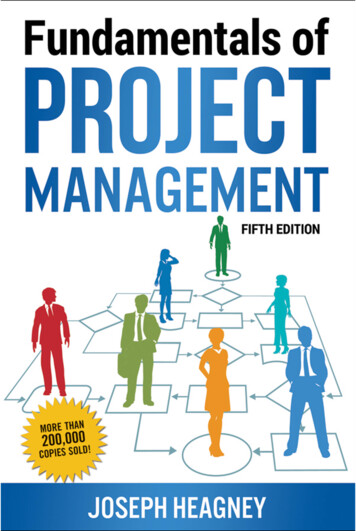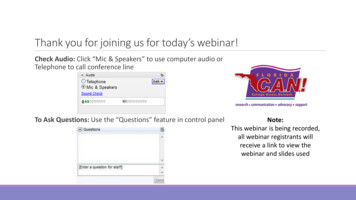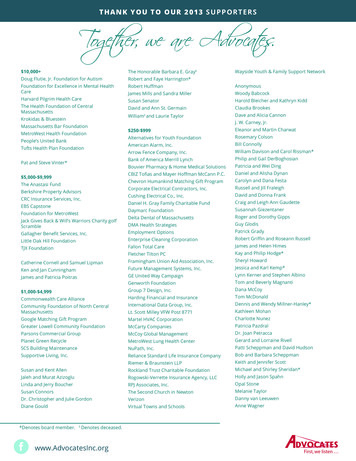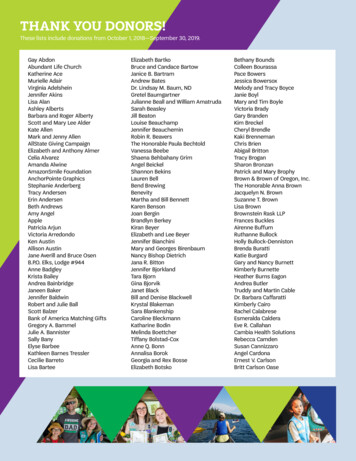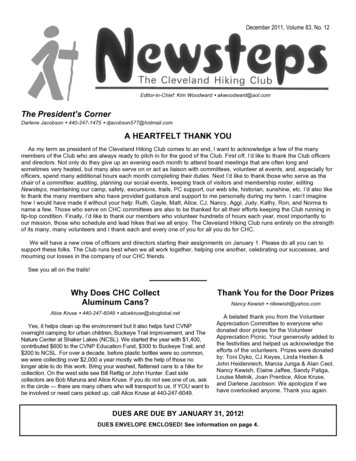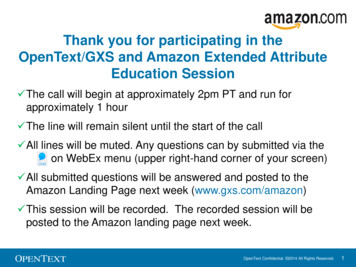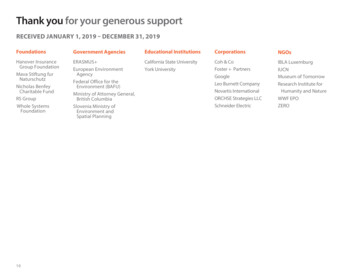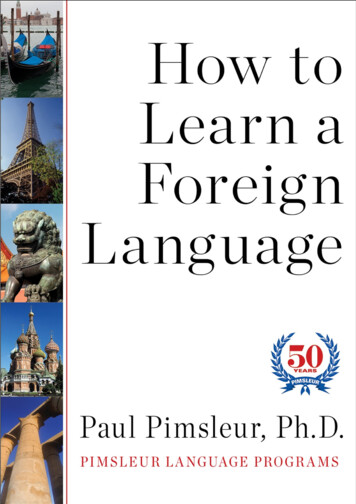
Transcription
Thank you for downloading Dr. Pimsleur’s How to Learn a Foreign LanguageSign up for our newsletter and receive special offers on Pimsleur Courses, news of upcoming languages, and other Pimsleurnews.CLICK HERE TO SIGN UPor visit us online to sign up atwww.pimsleur.com
Table of ContentsForewordPaul Pimsleur’s Life & CareerForeword to the First EditionThe “Whys” of Language Learning1. Everyone Can Learn Another Language2. When Is a Language Easy to Learn?3. How Long Does It Take to Learn a Language?4. Which Language Should You Select?5. Learning the “Tricks of the Trade”6. Organic Learning7. The Words and the MusicThe “Hows” of Language Learning8. How to Practice Pronunciation9. How to Master Grammar10. How to Learn VocabularyConclusion11. Beyond the Spoken WordAnswer Key for Quiz on “Guessable” French WordsAppendix 1: Languages of the WorldAppendix 2: Published Pimsleur Language ProgramsEnglish as a Second Language ProgramsAbout Paul Pimsleur
For Jean
ForewordFor me, this is the perfect book on learning a new language.It is all the things most language learning tools are not. It’s direct, full of useful pearlsof wisdom that are easily incorporated into one’s day-to-day study of a new language. It’sclear and well written, and nowhere does “academic-speak” sneak into the text.Paul Pimsleur’s theories, as expressed in How to Learn a Foreign Language, aredeceptively simple. In his own teaching, Dr. Pimsleur saw students repeatedly failing andbeing turned off of what to him was the most exciting challenge in the world: learning anew language.This book speaks equally to the different kinds of would-be language learners—fromthose who thought themselves scarred for life by high school Spanish hell to the moreconfident learners who want to approach the full range of different languages. You’ll besurprised at the Foreign Service Institute’s (FSI’s) grouping of “easy” to “hard” languages:what language ranks where isn’t entirely obvious.Paul Pimsleur was very direct in his advice on what to look for in a teacher: when theclassroom experience is not going to help you learn and when it is, when you’re withinyour rights to object to your time being wasted by methods that aren’t going to teach youanything.A lot of what I’ve come to know as the Pimsleur Method is developed from the groundup in this book.As Pimsleur walks you step-by-step through his straightforward advice on how to learna language, so he sets out the principles of the Pimsleur Method, answering many of thequestions I’ve had about the reasoning behind the program. By the end of this short book,you’ve gotten the benefit of his years of experience and the results of his research that ledto defining the behaviors proven to result in your learning a new language more easily.I’m also lucky to be in frequent contact with Dr. Pimsleur’s wife, Beverly, and hisdaughter, Julia, both of whom cheer us on in spreading the word about Pimsleur. Asimportantly, they each keep Paul Pimsleur from becoming a lifeless statue, constantlyproviding insights and anecdotes about Pimsleur that enable us to think of him as presentin our daily business.It has been some thirty-seven years since Paul Pimsleur died of a heart attack while hewas teaching at the Sorbonne in Paris. His wife, Beverly Pimsleur, brought the manuscriptof this book to Charles Heinle, the original publisher, and he published it in 1980. It was
Charles’s wife, Beverly Heinle, Pimsleur Language Programs editor-in-chief, whosuggested we republish it as part of our fiftieth anniversary celebration in 2013.The statistics and other reference materials are more than thirty years old, but theyremain directionally correct—the underlying point would be the same if they were alltranslated to 2013 values.I only wish this edition could reflect what Dr. Pimsleur would have done with all of thenew technology that has emerged in the ensuing thirty years. He was always in theforefront: in the 1960s he was responsible for developing the first computerized languagelaboratory at Ohio State University, where he set up a venture with Ohio Bell TelephoneCompany that enabled students to learn at their own pace, dialing in directly to hearpreprogrammed tapes. I can’t help but think he’d admire the revolutionary CourseManager App we’ve developed.To celebrate the fiftieth anniversary of the Pimsleur programs, we are republishing PaulPimsleur’s original How to Learn a Foreign Language. It is astonishing how it has stood thetest of time.The mechanical delivery systems have changed: for cassettes, records, and taperecorders, you can now read in CDs and downloads. The political alignments in Appendix1, “Languages of the World,” have changed, but the languages remain. The number ofspeakers listed in Table 2, “The Twelve Most Widely Spoken Languages,” has increased,and the ranking order of the languages fluctuates, but they are still the most widelyspoken.And all the rest holds true: Paul’s wisdom is as valuable today as it was when it wasoriginally published.Robert Paris RigerPimsleur Language Programs
Paul Pimsleur’s Life and CareerPaul Pimsleur (October 17, 1927–June 22, 1976) was a scholar in the field of appliedlinguistics. He developed the Pimsleur language learning system, which, along with hismany publications, had a significant effect on theories of language learning and teaching.Paul Pimsleur was born in New York City and grew up in the Bronx. His father,Solomon Pimsleur, was from France and a composer of music; his American-born motherwas a librarian at Columbia University.Dr. Pimsleur earned a bachelor’s degree at the City College of New York; he received amaster’s degree in psychological statistics and a Ph.D. in French, both from ColumbiaUniversity.He first taught French phonetics and phonemics at the University of California, LosAngeles. After leaving UCLA, Pimsleur went on to a faculty position at Ohio StateUniversity, where he taught French and foreign language education. At the time, theforeign language education program at OSU was the major doctoral program in the fieldin the United States. While there, he created and directed the Listening Center, one ofthe largest language laboratories in the United States. The center was developed inconjunction with Ohio Bell Telephone and allowed self-paced language study using aseries of automated tapes and prompts that were delivered over the telephone.Dr. Pimsleur, along with a number of renowned linguists and experts in the field oflanguage teaching, was called to Washington, D.C., in 1962 for a discussion on whatcould be done to improve foreign-language teaching in the United States. Math andscience were not the only areas that had been found wanting when the U.S. educationsystem was examined in the wake of Sputnik and the Soviets winning the race to space.Dr. Pimsleur proposed creating a self-study audio language program based on his ownclassroom methodology and his experience with students at the Listening Center. In orderto be able to judge the effectiveness of his approach, he was asked to choose a language notfamiliar to most English speakers. He chose Greek, which also had the advantage ofadded difficulty because of a non-Latin alphabet.Pimsleur and his wife, Beverly (who served as his researcher as he produced andrecorded the course), went to Greece in March 1962. They returned in August of thatyear, and the first Pimsleur course, Speak & Read Essential Greek: A Tapeway Program, wasself-published in March 1963. The subsequent languages undertaken by Dr. Pimsleurwere French (1964), Spanish (1966), German (1967), and Twi (1971).
Later, Pimsleur was a professor of education and romance languages at the StateUniversity of New York in Albany, where he held dual professorships in education andFrench. He was a Fulbright lecturer at the Ruprecht Karls University of Heidelberg in1968 and 1969 and a founding member of the American Council on the Teaching ofForeign Languages (ACTFL). He did research on the psychology of language learning,and in 1969 was the section head of psychology of second languages learning at theInternational Congress of Applied Linguistics.His research focused on understanding the language acquisition process, especially thelearning process of children, who speak a language without knowing its formal structure.The result of this research was the Pimsleur language learning system.Through this research, he identified three factors that could be measured to calculatelanguage aptitude: verbal intelligence, auditory ability, and motivation. He was one of thefirst foreign language educators to show an interest in students who have difficulty inlearning a foreign language while doing well in other subjects.After Dr. Pimsleur’s death, the ACTFL-MLJ Paul Pimsleur Award for Research inForeign Language Education was created and is awarded annually.
Foreword to the First EditionThe manuscript of this little book about foreign languages and how to learn them wasplaced in my hands by Paul Pimsleur’s widow, Beverly Pimsleur, some three years after herhusband’s untimely death in Paris, where he was teaching at the Sorbonne.She told me how very much Paul had wanted to see this book published and that shethought language students everywhere should have the opportunity to benefit from hisinsights and experiences as a master teacher. The pages of this book contain the essentialadvice that was at the very core of his own effective language teaching.Some time later, after I had read the work and, I must confess, with great delight overboth the content and the sparkling style, I called Beverly and told her that we wanted topublish it for two reasons: first, because the memory of her husband deserved this as afitting tribute to his outstanding contributions to the field of language pedagogy; andsecond, because not to make it available would be a considerable loss to all languagestudents, especially in the United States, where the study of foreign languages needs to beencouraged and developed so that North Americans can eventually take their place on theglobe as citizens of the world!This is clearly the place to mention the dream of Paul Pimsleur, to create a series ofcourses that would make easily accessible the major languages of the world to his fellowAmericans in a way that would facilitate the removal of that black spot “the uglyAmericans” from the lexicon of our neighbors on this ever-smaller globe.In fact, Paul Pimsleur accomplished a large part of his dream with the creation of hisSpeak and Read Essential Series, cassette courses for French, Spanish, German, Greek, andone for the African language Twi. These cassette courses are probably the most effectivetribute that could be made to the memory of this great language teacher, whose voice stillsounds clear and vital as it speaks through the tapes to provide instruction, information,and encouragement to the uncounted numbers of everyday and not-so-everydayAmericans who make the effort to expand their horizons and enjoy the culture andcivilization of other countries.Although How to Learn a Foreign Language is the posthumous publication of PaulPimsleur, his dream, as exemplified in the Speak and Read Essential Series, remains verymuch alive and, I believe, will continue to provide effective language instruction for yearsto come. The voice of the master teacher still resonates and sparkles on the tape as heteaches to all who come and listen.
This publication, then, is for the language students of the world, in memory of PaulPimsleur. Long may his voice be heard!Charles A. S. Heinle, PresidentHeinle & Heinle Publishers, Inc.
The “Whys” of Language LearningA few years ago a prominent physician, head of neurophysiology at a medical school,struck up a conversation with me at a party. When he discovered that I was a languageteacher, he grew eager to relate to me his bad experience with languages in school. Histone of voice made it plain that he had a long-standing negative recollection and wantedto get it off his mind.“French was destroyed for me,” he said, “by my junior high school teacher . . . who wasactually a gym teacher substituting in French.” He explained that the teacher had a verypoor accent. He found this out when his parents helped him with his homework one day.They taught him to pronounce certain words that his teacher had completelymispronounced. From then on, he was obliged to mispronounce them deliberately in class,to avoid offending the teacher.The physician went on to Cornell University. There he learned Russian, mastering itwell enough to take advanced courses where only Russian was spoken. But even his successwith Russian was not enough to offset his belief that he was poor at French—incapable oflearning a language that he knew to be easier than Russian.This sort of incident is not a rarity. Especially in well-to-do neighborhoods wherefamilies go abroad, many children pronounce the foreign language better than theirteachers, and encounter difficulties in their classes when they might be enjoying a specialsense of mastery.This book is about foreign languages and how to learn them. However, as in the case ofthe aggrieved physician, so many people come to this subject traumatized by badexperiences in school that some common misconceptions must be laid to rest before wecan even approach what for many people is a “loaded” topic.The following statistics indicate the extent of harm done in high school languageclasses. Of all students who take a language in high school, half drop it after only one year.By the end of two years, nine out of ten have given up language study entirely. A verysmall percentage of U.S. high school students actually learn a foreign language wellenough to read it comfortably or to speak it with any fluency. Most of the rest come awayconvinced that they cannot learn a foreign language.People in many parts of the world speak several languages as a matter of course. InAfrica, there are
Answer Key for Quiz on “Guessable” French Words Appendix 1: Languages of the World Appendix 2: Published Pimsleur Language Programs English as a Second Language Programs About Paul Pimsleur. For Jean. Foreword For me, this is the perfect book on learning a new language. It is all the things most language learning tools are not. It’s direct, full of useful pearls of wisdom that are easily

